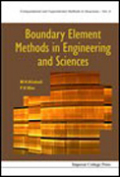
The boundary element method (BEM), also known as the boundary integral equation method (BIEM), is a modern numerical technique which has enjoyed increasingpopularity over the past two decades. It is now an established alternative totraditional computational methods of engineering analysis. The main advantageof the BEM is its unique ability to provide a complete solution in terms of boundary values only, with substantial savings in modeling effort. This book isdesigned to provide readers with a comprehensive and up-to-date account of the method and its application to problems in engineering and science. Each chapter provides a brief description of historical development, followed by basic theory, derivation and examples. INDICE: The Boundary Element Method for Geometrically Nonlinear Analyses of Plates and Shells (P H Wen et al.); Time-Domain BEM Techniques (W J Mansur et al.); The Boundary Element Method for the Fracture Analysis of the General Piezoelectric Solids (M Denda); Boundary Integral Analysis for Three-Dimensional Exponentially Graded Elasticity (J E Ortiz et al.); Fast Hierarchical Boundary Element Method for Large Scale 3-D Elastic Problems (I Benedetti et al.); Modelling of Plates and Shallow Shells by Meshless Local Integral Equation Method (J Sladek et al.); Boundary Element Technique for Slow Viscous Flows About Particles (A Sellier); BIT for Free Surface Flows (G Baker); Simulation of Cavitating and Free Surface Flows using BEM (S A Kinnas); Condition Numbers and Local Errors in the Boundary Element Method (W Dijkstra et al.).
- ISBN: 978-1-84816-579-3
- Editorial: Imperial College
- Encuadernacion: Cartoné
- Páginas: 412
- Fecha Publicación: 01/01/2011
- Nº Volúmenes: 1
- Idioma: Inglés
